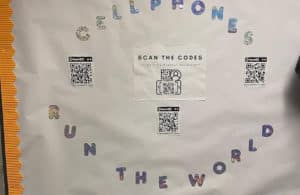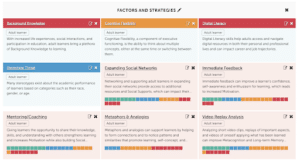Leveraging Strength Factors to Impact Teaching
Coach Dawson has been in the education field for 17 years. As a Special Education teacher, she taught in elementary, middle, and high school settings in self-contained, co-taught, and resource environments, as well as working with students in hospital and home environments. She has worked with students with a variety of disabilities and assistive technology needs. Currently, she manages the Verizon Innovative Learning Initiative and Innovation Lab at Long Middle School and is an HP Teacher Fellow through Digital Promise.
Coaching a First Year Special Education Teacher
I have been coaching Mr. H, a first-year special education teacher from a non-traditional teaching route, since I began working as the Verizon Innovative Learning Schools (VILS) Coach at Long Middle School. This teacher is currently pursuing his Master’s of Art in Teaching at Clark University in Atlanta, GA. He often asks for help with his graduate school assignments and other special education paperwork requirements for his caseload.
He teaches 8th-grade math in both co-taught and resource classroom settings. His co-taught classes have between 10-14 students with identified IEPs out of the whole class of 24 students, and his resource classes have between 8-10 students that require small group instruction due to being 3 or more grade levels below in math. In his classroom, he struggled with classroom and behavior management. He also struggled with modifying the boxed curriculum required by the district for his resource students and that caused many of them to struggle with learning even in the small group setting.
Since he transitioned to education from another field, he was challenged with having the skills to modify curriculum and provide accommodations, as well as manage difficult behaviors in his classroom. His strengths are that he is young and can culturally identify with the students, and that he enjoys using and learning technology.
Learner Variability Navigator (LVN) as a Center for Coaching Work
After meeting with the teacher on several occasions and observing in his classroom, I reviewed the Adult Learner model of the Learner Variability Navigator on factors that I noticed impacting his teaching and classroom management.
I noticed the factor background knowledge as he was a first-year teacher from a non-traditional teaching track and lacking knowledge that traditional track teachers gain in their teacher education programs. Identifying cognitive flexibility as another factor helped me focus on his ability to switch between content, tasks, activities, and managing his classroom simultaneously. He was struggling with how to handle behaviors or disruptions from students while teaching a lesson. I chose the factor digital literacy because he is comfortable with technology. I thought that this may offer us a strength to build upon with educational technology that was available for him to use in his classroom. Stereotype threat was chosen based on my interview with him and comments regarding what he personally struggled with regarding his own identity as a black male in the LGBTQ community.
During our coaching sessions, I implemented strategies such as: Expanding Social Networks, Immediate Feedback, Mentoring/Coaching, Metaphors/Analogies, and Video Replay Analysis
By the end of our term, we completed a full Coaching Cycle that was successful in increasing his Teacher Evaluation scores. I was able to leverage his strength factors to impact his teaching through the use of Social Networking, Metaphors/Analogies, and Video Replay Analysis. Furthermore, we implemented web-based tools to include in his teaching to increase student engagement.

The Impact on Student and Teacher Learning
After a lesson on leveraging QR Codes to showcase student work, the teacher created a bulletin board with QR Codes that link to student videos discussing the Project-Based Learning unit they had recently completed. This impacted student learning by allowing students to practice their content along with digital skills to create their videos on the impact they found cell phones had on adolescents. They were so proud of their work that they would often have their friends stop in the hallway to scan the QR Code and view their video. Furthermore, it provided a glimpse into their research and project conclusion that could be viewed by any visitors in the building. By adding digital skills, one of the teacher’s strengths, into the learning environment, the teacher was able to decrease disruptive behavior during this project.

Due to our work on expanding social networks to address his stereotype threats, digital literacy, and background knowledge, the teacher campaigned within his school and successfully became part of the school Governance Team.
Reflections
Big Takeaway
Overall, I noticed a change in the teacher’s dedication to learning in professional development and his extra time spent working with me to learn technology tools to use in his classroom. He became less frustrated with the students and more focused on what he could do to help them before they got to the point of disruptive behavior. As a teacher leader on the school governance team, he has been more involved in after-school activities with students and staff. He has also started to share technology tips or interesting information he learns through Social Media platforms that could be helpful to other teachers in the building.
What I would tell other leaders during this time
Using the Learner Variability Navigator allowed me to first identify strength factors of the individual teacher and then leverage those factors into specific, research-backed coaching strategies. This process allowed the teacher to decrease immediate classroom challenge points as well as impact longer term leadership and professional learning growth.
Resources
About The Author
Renee Dawson
Renee Dawson is an Educational Technology Specialist and Verizon Innovative Learning Coach and Innovation Lab Mentor. She has a passion for helping the often overlooked students find their passion for technology. Renee has her B.S. in Special Education from Georgia Southern University (2006), her M.Ed. in Physical and Health Disabilities from Georgia State University (2012), and her Ed.S. in Instructional Technology from Kennesaw State University (2014). She is passionate about providing teachers with high quality, differentiated professional learning on technology, as well as personalized learning. Renee currently resides in Atlanta, GA with her partner, Will, and their dogs, Pig and LuLu.
Verizon Innovative Learning Schools
Digital Promise collaborates with Verizon to equip every student and teacher at select middle and high schools across America with a device and up to a four-year data plan, and provide students without reliable home internet access with a mobile hotspot. In addition to free technology and access, Verizon Innovative Learning Schools receive extensive teacher training, support, and the opportunity to engage in a unique, immersive curriculum to leverage technology in their classrooms.


